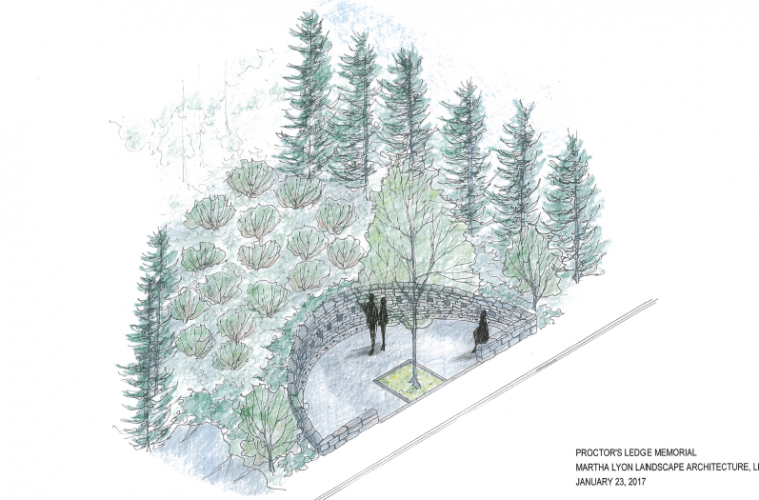On January 26, the City of Salem announced the final design for the planned memorial at Proctor’s Ledge to honor the “witch” executions that took place in 1692. Last year a team of researchers and historians identified the location as the probable site of the executions and in the months that followed, city staff and a consulting landscape architect worked with descendants of the victims, the Salem Award Foundation, local historians, and abutting neighbors to develop a plan that would tastefully memorialize the site.
“I would like to thank everyone who participated in the process that led to the development of this respectful memorial design,” said Salem Mayor Kim Driscoll, in a press release. “Salem is constantly looking to the lessons of the past. Whether it was through the formation of our No Place for Hate Committee and our landmark non-discrimination ordinance, or through the good work of the Salem Award Foundation, the lessons we learn from our history directly inform the actions we take today. Having this site memorialized, especially as we prepared to mark the 325th anniversary of that tragic event, presents an opportunity for us to come together as a community, recognize the injustice perpetrated against those innocents in 1692, and recommit ourselves to the values of inclusivity and justice.”
The design and construction of the memorial, as well as improvements to the streetscape and the parcel itself, were funded primarily through a $174,000 Community Preservation Act grant. The design of the memorial and landscaping plans for the site were developed by landscape architect Martha Lyon through a participatory public process and meetings on site with abutters.
Mayor Driscoll is asking the Parks and Recreation Commission to consider directing $0.25 from each ticket sold at the Witch House, the home of Jonathan Corwin, who, as a judge during the Witch Trials of 1692, had a direct role in sentencing the victims who were executed at Proctor’s Ledge, to fund maintenance and upkeep of the memorial.
The memorial plans call for a landscaped slope down from the ledge where the executions are believed to have taken place. At the base of the slope, on Pope Street, there will be a semi-circular area surrounded by a stone wall. Stones with the names of the 19 individuals hanged near the site will be set into the wall and lit from the ground below with a single light on each name. While trees will be planted along the perimeter of the parcel itself, at the center of the memorial on Pope Street there will be a single oak tree, as a symbol of endurance and dignity.
Already completed at the site last year are streetscape improvements on the Proctor Street side of the parcel intended to calm traffic passing by the location and provide a safe and accessible viewing area for those visiting. Undergrowth and trash were removed from the site and, in the next few weeks, fencing and screening plantings will go in to provide privacy for abutting neighbors and to help maintain the integrity of the historic site itself.
Construction for the memorial is slated for April with bidding for the project expected to begin within the next two to three weeks. The goal is to have the project completed in time for a spring or summer dedication ceremony, marking 325 years since the executions took place on the ledge.

